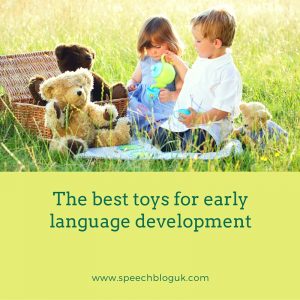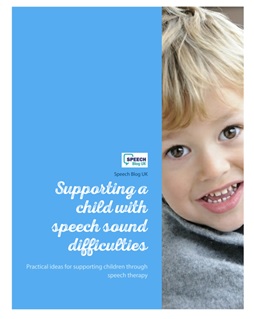I have recently been working with a number of younger children. As speech therapists we are regularly contacted by families seeking reassurance and assessment for their 2 year old who isn’t talking yet. One question that often comes up is “What toys or games will help my child?”.

There are so many toys available for babies and toddlers. How do you know what to choose? As a general rule, try not to have too many of the ‘beepy/ flashy’ toys – you know the ones I mean! The all singing all dancing, highly motivating ones. These toys are great at engaging babies and toddlers, but not everything in life is high impact like this. It doesn’t allow children to develop their play or sequencing skills. It doesn’t allow them to create stories or use their imagination. It’s fine to have a few, but there are many other toys out there.
My other word of advice is to ignore the ‘age range’ on toys. Now, I’m not suggesting you give a baby lego – lets be sensible here, but if your 3 year old still loves a toy labelled for 18 months that is fine. It’s more about how they are playing with a toy rather than who it was designed for.
Play food and a tea set. This could be a set bought from a shop or you could get some pots, pans and wooden spoons from the kitchen. You can target and help so many language skills with play food and some pots and pans! Here are just a few ideas
Vocabulary – can they name the items of food
Understanding of language – can your child follow an instructions e.g. where’s the spoon? Can I have some cake please?
Concepts – I can’t eat that raw we need to cook it. The foods too hot, lets blow on it too cool it down.
Sequencing – we pour the tea in the cup, stir it and then drink it.
Social interaction – Can mummy have a drink? Teddy’s hungry, shall we get him some food. Another key point in using these sorts of toys is to play with your child to show them what to do and extend their play. This is how they learn to take turns and share.
Farm or zoo animals. As above, a set of animals toys will target all the same skills. With younger children, you might start with the noises the animals make rather than their names (although I still haven’t found a good noise for a giraffe!). You can also work on some simple verbs. You can pretend that its night time and the animals are going to sleep. Lie them down and put them to bed, say night night etc. Then you can wake them up. You can also make the animals run or jump.
Dolly or teddy Showing your child some simple play sequences with a dolly or teddy is really useful. Having an understanding of order and sequence is vital in ordering words into sentences. Play can mirror your normal daily routines, for example bed time – wash dolly, brush teeth and then put them to bed. This is a great time to work on body vocabulary – “Can you wash dolly’s tummy?”, “Can you wash teddy’s toes?” You can also make up stories about what dolly or teddy are going to do. Are they going to go to the park or to the shops? What are they going to do when they get there? If your child finds this hard, give them two options to choose from. “Are they going to play on the swing or the slide first?”
Simple lift the flap books It’s never too early to encourage your child to enjoy books. I often hear parents say that their child isn’t interested in books. However often what they mean is that the child isn’t yet ready to sit and listen to a story. At first you may only get your child to join in for a few pages, but that is fine. You can add an extra page each time you try. Don’t worry about reading all the words on the page. You can keep it short and get to the bit where they can lift the flap. My favourite is still Dear Zoo!
You! I know this is cheating but you will always be the best teacher and most exciting play mate for you child. It is from you that they learn how to interact and communicate. Simple games like peek-a-boo or tickling games are teaching you child to anticipate, request, react, vocalise – and many more skills.
Make time each day to play with your child and interact using whatever interests them. I will always remember when my son was little he loved watching the bin men and the big truck each week on bin day. So every Thursday, normally still in our pyjamas, we were at the window or door watching the bin men! So many chances to say “look, here they come” and “Up, up, up….down, down, down”. We also had very lovely bin men who waved back at us!






After 20 years in elementary and preschool classes, I began teaching in an EIP program (early intervention) and fell in LOVE. Quickly learning what the 6mos to 3 year old population enjoyed most, it was simple to fill a bag and go! Both genders loved music, so nursery rhymes, preschool songs and even made-up songs for daily routines (brushing teeth washing hands etc) worked well. Many simple songs are on CDs, of course. Girls loved small family doll sets with furniture props, play foods puzzles. Early puzzle learners enjoy the shapes you fit in the appropriate shape in boxes. the boys also loved puzzles, firemen doll sets with trucks. However when it came to play foods, they were most verbal when naming and tossing the foods into basketball hoops or paper bags, LOL!
Everyone used early vocabulary/verbs when painting. Often, I’d get small houses from craft stores to paint and decorate with stickers. I would suggest to undergrad SLPs to follow little ones’ leads for toys/items of interest; which included nearly all in their environment. Eliciting verbalization is fun and exciting. Note to parents: narrate throughout the day: ” Time to wipe the table, Mommy’s folding the clothes” . Since and 2 year olds learn through imitation, listen for their approximations of your model. Ex: it might sound like “why tay” for wiping table. Good luck and enjoy such an adorable group of learners.
Lots of lovely ideas for early language development – thanks for sharing!